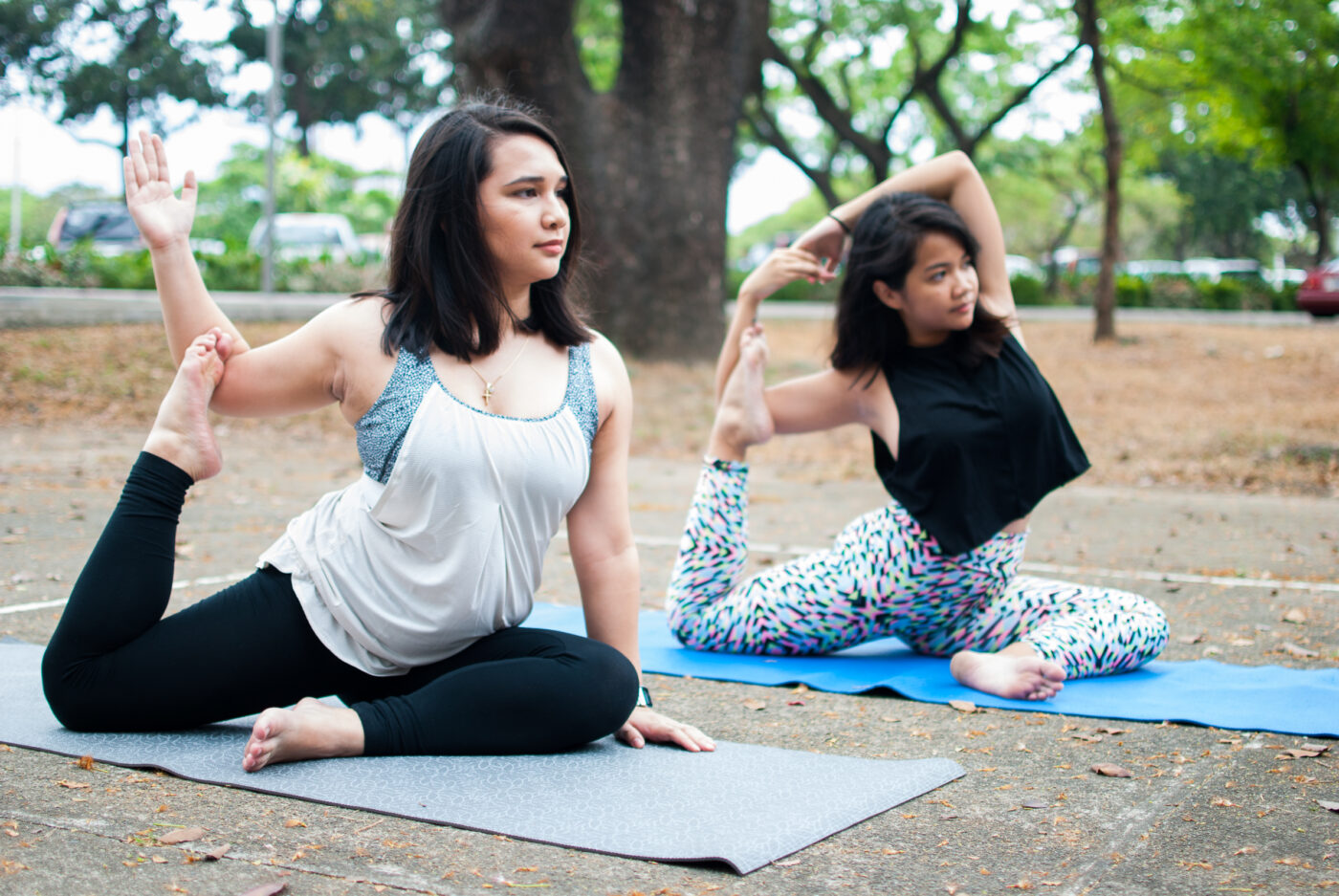“Now, for the Warrior!” I felt princely indeed as I followed after Sir Henry’s majestic pose, arms outstretched, as if surveying one’s domain. Ten seconds in and it was more like surfing—rather, it felt like riding a wave of aches and trying not to fall. And both my feet were still on the ground; to think we weren’t yet on the one-legged or seemingly-flying poses.
On the face of it, yoga, with its slow and graceful movements, looks like an easy physical exercise—one doesn’t associate the ads of sweat-drenched and exhausted athletes with the practice. Aside from the teacher correcting wrong poses, there is minimal contact save for that between the student and the ground.
Yet creative writing senior Cathy Dario adds that there is more going on under the surface than just physical strengthening. Dario has been practicing daily for almost a year, and is enthusiastic in sharing about having gotten more than asked for, initially after physical exercise.
The medical and health community acknowledges such benefits, as mentioned in a November 2010 Science Daily report. It’s notable that yoga doesn’t only support conventional exercise and physical flexibility, but also flexibility of mind stemming from emotional stability. The language has changed, but the spirit remains the same from 2000 years ago: What were once called chakras and their corresponding colors are linked today to the endocrine system and their corresponding hormones.
Regular practitioners of yoga like Dario have reported improvements not only in terms of physical strength, but also in terms of mental and emotional endurance. In a fast-paced and demanding urban corner of the world, it is little wonder why the ancient practice, being both a physically-involving yet mentally-calming practice, has gained a following as a complement to familiar sports and recreational activities. For many, yoga combines both a work out and a chill out.
No mud, no lotus
The 1960s were a time of turmoil the world over. Civilization was threatened by nuclear war and closer to home, martial law took root. The political chaos following war in Asia and colonialism’s fall saw refugee gurus like Thich Naht Hanh and Prabhat Sakar journeying to the West to establish wellness centers, teaching practices derived from yoga. In the midst of this, the youth counterculture of the time experimented with contemporary renderings of ancient practices in the form of spirituality, hallucinogens, and physical exercises.
Yoga formally reached the Philippines in 1967, when the orange-turbaned Ananda Marga monks established a center in Sikatuna village in Quezon City. Aside from classes on poses, the center has offered spiritual mentorship and talks on ethics. Today, after a hearty trip along Maginhawa Street’s mecca of restaurants, one can seek a different kind of fullness at the center, which operates on donations from those who have benefitted.
It is notable that such an upkeep scheme has proven sustainable. Today, however, it’s more common for studios and yoga teachers to teach professionally, fees and all. In the United States, the yoga industry now generates billions of dollars in merchandise and manpower.
From such developments, yoga styles today are as varied as the iterations of poses. From headstands to saunas to holding one’s balance while suspended in midair, new paths of practice are being innovated. Like a slow-blooming lotus, the practice’s popularity has unfolded quietly and steadily through the decades, taking root and creeping upwards into the awareness of people to the point of being a part of the everyday lives of many.
Mind within matter
More than ever, yoga centers and studios have popped up around the metropolis with teacher-training courses offered to dedicated practitioners. Communications technology management senior Danette Suyosa is one such teacher who, after having practiced for nine years, now holds regular classes in White Space studio along Katipunan Avenue.
An essential part of yoga is mindfulness—training one to be grounded in the present moment while going about daily affairs. Suyosa shares, “I try to integrate mindfulness in my yoga classes in that I try to show my students that they are not their thoughts, [that] they can be detached from negative automatic thoughts.” Yoga aims to cultivate such an attitude, where one has to balance between intense concentration and relaxation to hold a pose with poise.
Given a decentralized approach to teaching, the contemporary practice has not gone without controversy. Loyola Schools physical education teachers and yoga instructors Henry Oliva and Ramil Iriola, who have respectively been teaching for 25 and 15 years, warn that teachers, being human too, are prone to err.
They explain that the energy cultivated by yogic exercise is neutral, and without proper guidance, can be abused. Intense libido, from aroused hormones, is one such effect: Sex scandals have been cited as far back as the early 20th century. Injuries have also been frequently reported. These happen more from long periods of improper application than acutely in studios as slightly wrong poses contribute, over time, to damaged bones.
Clear, flowing water
That is why Oliva and Iriola remind students that yoga cannot be isolated from its traditional practice dating back to the 6th century BCE. They say what today is marketed as “yoga” is really an emphasis on asana, or physical postures, but only one of the “eight links” of yoga. The Monier-Williams Sanskrit-English dictionary translates “yoga,” as used in the ancient language of the Vedas, as “to unite.” The other links include ethical training, meditation, and other exercises in mental absorption.
Classical yoga was part of the Vedanta tradition of Hindu religion whose ultimate goal was no less than enlightenment. Acknowledging such mystical underpinnings, Oliva and Iriola, in the midst of laughter, restate enlightenment as an individual coming to know one’s nature. Oliva finally concedes, “Kase, if you see your true nature, ang stress, mawawala (If you see your true nature, stress reduction follows).” Yoga’s poses were originally intended, after all, to support periods of concentrated self-study and prayer.
Throughout the millennia since its inception in ancient India, practices derived from yoga have shaped much of East Asian culture. Yoga’s cultivation of decisive, unflinching, and mindful action has made inroads into fields as diverse as landscaping, archery, swordsmanship, calligraphy, tea ceremony, painting, and poetry. Yoga, indeed, unites.
Suyosa shares that she does not differentiate between yoga and meditation in her practice and teaching. She says, “I actually could classify it [the combined practice] as ‘just yoga.’” It could be said that stress is also reduced in ethical and psycho-emotional terms. One’s transactions with the world are reshaped.
Recognizing this, psychologists such as John Teasdale and Jon Kabat-Zinn, respectively from Oxford and the University of Massachusetts, have developed mindfulness-based therapy programs based on yoga’s tenets. One such program, Mindfulness-based Cognitive Therapy (MBCT) has been offered as a class by the Loyola Schools’ Psychology Department. The behavioral applications of mind-body wellness are explored as students themselves are taught to facilitate MBCT sessions.
Yoga, a stone hitting multiple birds, continues to flourish in a world where the perennial concerns of humankind remain constant especially in the face of a materially efficient society with rapidly evolving technology. Going beyond muscle memory, a dedicated practice of yoga reconnects one with the art of daily living. Mindless “chores” are transformed into mindful affirmations of the world around. Hostilities perceived in the world may just be reshaped as an internal poise is cultivated from an outward pose.
While still in the process of rediscovery, there is no denying that yoga has provided answers to questions ranging from a good way to keep fit to a skillful means to tick off New Year’s resolutions. And often, the best answers, which speak louder than words, are made flesh—literally.







